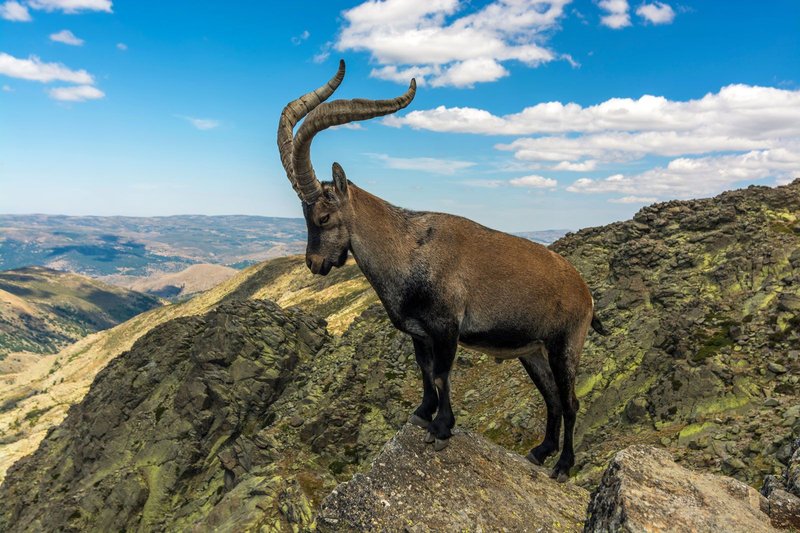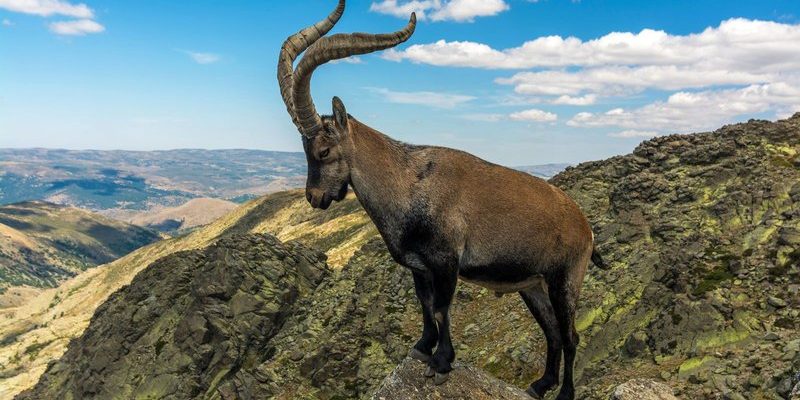
The Ibex is a fascinating animal, often found in the rugged terrains and steep cliffs of the mountains. Imagine a creature that seems to dance effortlessly on rocky ledges, defying gravity with its agile movements. These goats are not just experts at climbing; they are also stunning to look at with their impressive curved horns and sturdy physique. If you’ve ever wondered about their habitat, behavior, or unique adaptations, you’re in for a treat!
Originally found in the European Alps, the ibex has captured the hearts of nature lovers and adventurers alike. They thrive in some of the most harsh and breathtaking environments on the planet. But despite their strength and beauty, they face challenges in their natural habitats. Understanding the ibex can help us appreciate their role in our ecosystems and the conservation efforts needed to protect them.
Physical Characteristics
Ibex are known for their impressive size and striking appearance. Males, or bucks, stand around 3 to 4 feet tall at the shoulder and weigh between 150 to 300 pounds. Females, or does, are smaller, typically weighing around 80 to 100 pounds. What sets them apart are their magnificent horns, which can grow up to 3 feet long, curling back like a majestic crown.
These horns aren’t just for show. They play a significant role in their social structure, especially during the mating season, where males engage in displays of strength to attract females. The ibex is covered in a thick coat that varies in color from light brown to dark grey, allowing them to blend seamlessly into the rocky environment. This coloration serves as an excellent camouflage against predators.
One of the most striking adaptations of the ibex is their cloven hooves, which are split into two parts. This unique feature helps them grip the mountainous terrain, giving them the ability to traverse steep and rocky landscapes with ease. Their remarkable agility is often compared to that of a ballet dancer, moving gracefully where others struggle.
Habitat and Distribution
Ibex are primarily found in the mountainous regions of Europe, Asia, and North Africa. They prefer steep, rocky cliffs and high-altitude areas where they can escape from predators. Their range varies among species: the Alpine ibex, for example, typically inhabits the European Alps, while the Nubian ibex roams the deserts of northeastern Africa.
These magnificent animals have adapted well to their harsh environments. They thrive in areas with sparse vegetation, often relying on grasses, shrubs, and lichen for food. In winter, when food becomes scarce, ibex can be seen moving to lower altitudes in search of sustenance. This adaptability is crucial for their survival in changing climates and habitats.
The ibex’s choice of habitat not only provides safety from predators but also plays a crucial role in their social dynamics. They often gather in herds, which helps them protect their young and maintain social structures. Observing these herds can be a breathtaking sight, especially when they navigate the steep cliffs with such confidence.
Diet and Feeding Habits
These mountain goats are herbivores, which means their diet consists strictly of plant material. An ibex’s diet mainly includes a variety of grasses, herbs, leaves, and shrubs. During spring and summer, they feast on lush vegetation, while in winter, they depend on tough, fibrous plants and shrubs that are still accessible.
One of the interesting aspects of an ibex’s feeding habits is their selective grazing. They often choose the most nutritious and easily digestible plants, which allows them to maintain their energy levels in their demanding environment. This selectivity is vital, as it helps them store fat that can be used during the harsher months when food is scarce.
Besides their diet, ibex have developed a unique way of obtaining water. They can go long periods without direct access to water, obtaining moisture from the plants they eat. However, they will seek out snow or ice during warmer months to quench their thirst. This remarkable adaptation helps them survive in their often arid habitats.
Behavior and Social Structure
Ibex are highly social animals. They typically live in herds that can range from a few individuals to over a hundred. These herds are usually made up of females and their young, while males tend to form bachelor groups, especially outside of the breeding season. This social structure not only helps protect individuals from threats but also fosters strong bonds among members.
During the mating season, which occurs in late autumn, males will engage in competition to win the attention of females. This competition can be fierce, with males often clashing their massive horns against each other in dramatic displays. Watching these confrontations is a fascinating spectacle, showcasing their strength and agility.
Ibex are also known for their vocalizations, which range from bleats to grunts. These sounds help maintain communication within the herd, especially when navigating through their rugged habitats. Their ability to communicate effectively is crucial for coordinating movements and alerting one another of potential dangers.
Conservation Status
While ibex are resilient animals, many species face threats due to habitat loss, hunting, and climate change. The IUCN (International Union for Conservation of Nature) lists some ibex species as endangered or vulnerable, primarily due to human activities. Conservation efforts are in place to protect their habitats and populations.
Protected areas and reserves have been established in many regions to provide safe environments for ibex to thrive. These efforts not only help stabilize the ibex populations but also promote biodiversity within their ecosystems. Community involvement is essential in these conservation projects, as local people play a crucial role in the animals’ protection.
Public awareness and education about the ibex and their unique adaptations are vital for their future. By understanding the challenges they face, we can all contribute to conservation efforts. Whether through supporting wildlife organizations or simply appreciating these magnificent creatures in their natural habitat, every step counts.
Interesting Facts about Ibex
| Size: | 3 to 4 feet at shoulder |
| Weight: | 150 to 300 pounds (males); 80 to 100 pounds (females) |
| Habitat: | Mountainous areas in Europe, Asia, and North Africa |
| Diet: | Herbivorous; grasses, shrubs, and lichens |
| Speed: | Up to 40 km/h (25 mph) |
| Lifespan: | 10 to 15 years in the wild |
The ibex is truly a remarkable animal, embodying the beauty and resilience of nature. From their incredible climbing abilities to their complex social structures, these mountain goats are a testament to the wonders of evolution. Understanding and protecting the ibex is not just about preserving a species; it’s about maintaining the health of their entire ecosystem.
Next time you find yourself in the mountains, take a moment to appreciate these incredible creatures. Whether it’s through a hike, a documentary, or simply reading about them, every effort helps raise awareness and support for their conservation needs. The ibex is not just a part of the mountain landscape; it’s a part of our global heritage.
FAQ
What is the difference between male and female ibex?
Males, or bucks, are significantly larger than females, known as does. Bucks display larger, more curved horns, which they use during mating season to establish dominance. Does tend to have smaller, straighter horns and typically form herds with other females and their young while males often come together in bachelor groups outside of breeding times.
How fast can an ibex run?
Ibex are surprisingly fast and can reach speeds of up to 40 km/h (about 25 mph). This agility is essential for escaping predators and navigating the steep, rocky terrains they call home. Their speed, combined with their excellent climbing skills, makes them formidable creatures in their natural environment.
Are ibex endangered?
Some species of ibex are classified as endangered or vulnerable due to habitat loss, hunting, and climate change. Conservation efforts are being made to protect their populations and habitats, emphasizing the need for awareness about their plight. Protecting these magnificent animals is critical to sustaining biodiversity in their ecosystems.
What do ibex eat?
Ibex are herbivores and primarily feed on grasses, shrubs, and lichen. Their diet varies with the seasons, as they adapt to what is available in their environment. They are known to be selective grazers, choosing nutrient-rich plants when available and, during tougher times, relying on tougher, fibrous vegetation.
How long do ibex live?
In the wild, ibex typically live between 10 to 15 years. However, their lifespan can be shorter in areas where they face more significant threats from predators or human activities. In protected environments, they may live longer, benefiting from better resources and reduced stress.
Can ibex survive in snowy conditions?
Yes, ibex are well-adapted to snowy conditions. They can move to lower altitudes in search of food when deep snow covers the mountains. Their ability to find nourishment in harsh environments is part of what makes them such remarkable survivors in their mountainous habitats.
Do ibex have any natural predators?
Ibex face several natural predators, including wolves, lynxes, and golden eagles. Young ibex are particularly vulnerable to these threats. Living in herds helps increase their chances of survival, as they can alert one another to the presence of predators and work together to evade them.
How are ibex social structures organized?
Ibex typically live in herds made up of females and their young, while males often form smaller bachelor groups. This structure allows for social interactions and competition during mating seasons, which is crucial for their reproduction. The dynamics within these herds are fascinating, highlighting their social behavior and communication skills.
What adaptations help ibex survive in steep terrains?
Ibex have several adaptations that enable them to thrive in steep terrains. Their cloven hooves provide excellent grip on rocky surfaces, allowing them to navigate cliffs easily. Additionally, their muscular build and balanced body help them maintain stability while climbing, making them agile and confident in their mountainous habitats.
How do conservation efforts help ibex?
Conservation efforts protect ibex by preserving their natural habitats and implementing regulations against hunting. Establishing wildlife reserves increases their chances of survival, allowing populations to stabilize. Foster community engagement through education and support for conservation organizations further enhance these efforts, ensuring that ibex continue to roam the mountains for generations to come.

